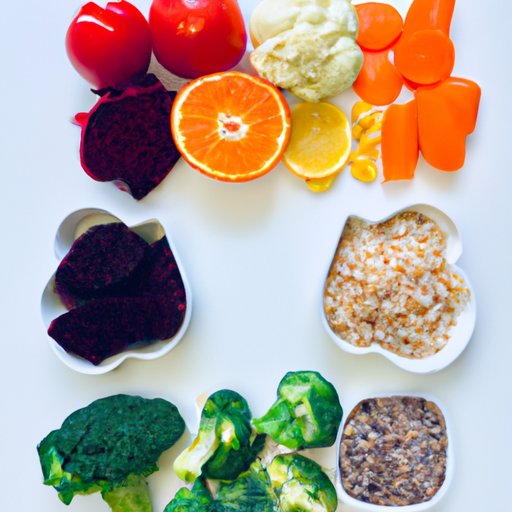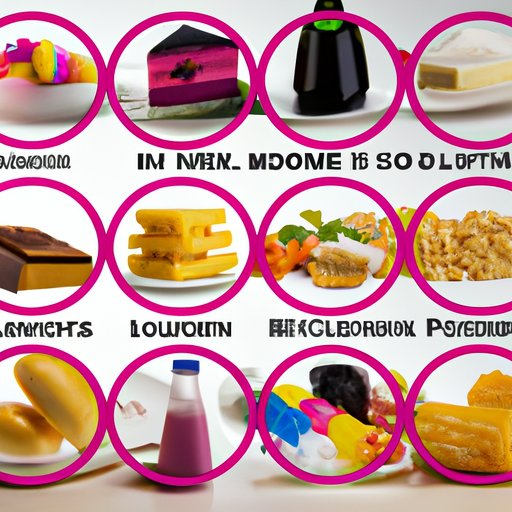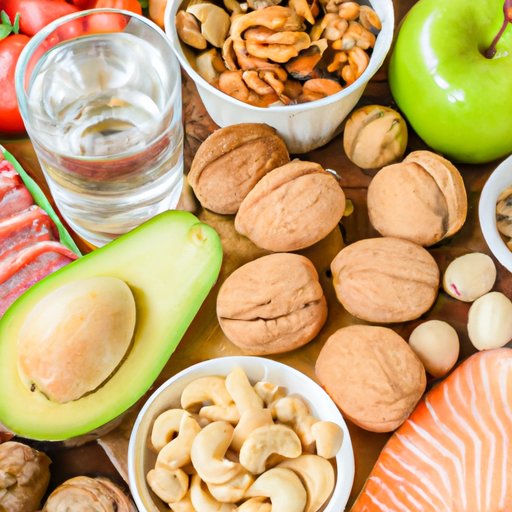Introduction
Eating healthy is an essential part of living a healthy lifestyle. It can help you maintain a healthy weight, reduce the risk of chronic diseases, and increase your overall wellbeing. But what exactly is healthy eating? In general, it’s consuming a balanced diet that includes nutrient-rich foods like fruits, vegetables, whole grains, lean proteins, and healthy fats.
In this article, we’ll discuss how to create a meal plan based on nutrient-rich foods, incorporate variety into your diet, focus on whole foods, limit processed and refined foods, eat enough fruits and vegetables, choose healthy fats and proteins, and drink plenty of water.
Create a Meal Plan Based on Nutrient-Rich Foods
Creating a meal plan based on nutrient-rich foods is one of the best ways to ensure you’re getting all the vitamins and minerals your body needs. Here are some tips for doing so:
Identify Nutrient-Rich Foods
The first step in creating a meal plan is to identify which foods are most nutrient-rich. These include fruits, vegetables, whole grains, legumes, nuts, seeds, lean proteins, and healthy fats. Aim to include at least one of these foods in each meal or snack.
Calculate Calorie Intake
Once you’ve identified which foods are most nutrient-rich, the next step is to calculate your daily calorie intake. This will help you determine how much of each food group to include in your meals. The average adult needs between 1,600 and 2,400 calories per day, depending on their activity level.
Design Your Meal Plan
Now that you know how many calories you need and which foods are most nutrient-rich, you can start designing your meal plan. Aim to make each meal a balance of complex carbohydrates, lean proteins, and healthy fats. Try to include several servings of fruits and vegetables every day as well. You can also use online resources to plan and track your meals.

Incorporate Variety Into Your Diet
Eating a variety of foods is key to maintaining a healthy diet. Here are some tips for incorporating variety into your meals:
Eat Different Types of Food
Try to eat a wide range of foods from all the different food groups, including fruits, vegetables, whole grains, lean proteins, dairy products, and healthy fats. Eating a variety of foods ensures that you’re getting all the essential nutrients your body needs.
Try New Recipes
Cooking at home is one of the best ways to incorporate variety into your diet. Try out new recipes or experiment with different ingredients to keep your meals interesting. You can also look up healthy recipes online for inspiration.
Focus on Whole Foods
Whole foods are unprocessed, unrefined foods that are as close to their natural state as possible. They are packed with nutrients, fiber, and other beneficial compounds. Here are some tips for focusing on whole foods:
Avoid Processed and Refined Foods
Processed and refined foods are usually high in sugar, sodium, and unhealthy fats. They are low in fiber and other essential nutrients. Try to limit or avoid processed and refined foods as much as possible and opt for whole foods instead.
Buy Fresh or Frozen Fruits and Vegetables
Fresh fruits and vegetables are always the best option, but frozen varieties can be just as nutritious. Frozen fruits and vegetables are often picked and frozen at their peak ripeness, so they retain most of their nutrients. Be sure to read labels carefully when buying frozen fruits and vegetables.

Limit Processed and Refined Foods
Processed and refined foods should only be eaten occasionally. Here are some tips for limiting these types of foods:
Read Labels Carefully
When buying packaged foods, read the labels carefully to make sure they don’t contain too much sugar, sodium, or unhealthy fats. Look for words like “whole grain” or “whole wheat” on the label, which indicates that the food is more likely to be healthier.
Choose Unprocessed Grains
When choosing grains, opt for unprocessed versions such as oats, quinoa, brown rice, and buckwheat. These are higher in fiber and other essential nutrients than processed grains like white rice and white bread.
Eat Enough Fruits and Vegetables
Fruits and vegetables are packed with vitamins, minerals, antioxidants, and other beneficial compounds. Here are some tips for making sure you get enough of them:
Incorporate Fruits and Veggies Into Meals
Aim to include at least one serving of fruits and/or vegetables in each meal. You can add them to salads, soups, omelets, stir-fries, and sandwiches. Or, try snacking on raw veggies, such as carrots and celery, throughout the day.
Make Sure to Get Enough Vitamins and Minerals
Fruits and vegetables are especially rich in vitamins and minerals, so make sure to consume a variety of them each day. Dark leafy greens, citrus fruits, and cruciferous vegetables are particularly good sources of vitamins and minerals.

Choose Healthy Fats and Proteins
Healthy fats and proteins provide energy and help build and repair muscle and other tissues. Here are some tips for choosing the right ones:
Select Lean Protein Sources
When selecting proteins, opt for lean sources such as fish, poultry, beans, and tofu. Avoid processed meats like bacon and salami, which are high in saturated fat and sodium.
Choose Healthy Fats
Healthy fats include unsaturated fats like olive oil, avocados, nuts, and seeds. Limit saturated fats like butter, lard, and coconut oil, as well as trans fats found in processed foods.
Drink Plenty of Water
Water is essential for keeping your body hydrated and functioning properly. Here are some tips for drinking enough water:
Stay Hydrated
Make sure to drink at least 8 glasses of water per day. You can also drink herbal teas, vegetable juices, and other low-calorie beverages.
Use Water as a Healthy Alternative to Sugary Drinks
Sugary drinks like soda and energy drinks are high in calories and offer little nutritional value. Opt for water instead, which is calorie-free and hydrating.
Conclusion
Eating healthy is an important part of living a healthy lifestyle. To do so, create a meal plan based on nutrient-rich foods, incorporate variety into your diet, focus on whole foods, limit processed and refined foods, eat enough fruits and vegetables, choose healthy fats and proteins, and drink plenty of water.
By following these tips, you can enjoy a variety of delicious and nutritious meals while reaping the benefits of eating healthily.
(Note: Is this article not meeting your expectations? Do you have knowledge or insights to share? Unlock new opportunities and expand your reach by joining our authors team. Click Registration to join us and share your expertise with our readers.)
